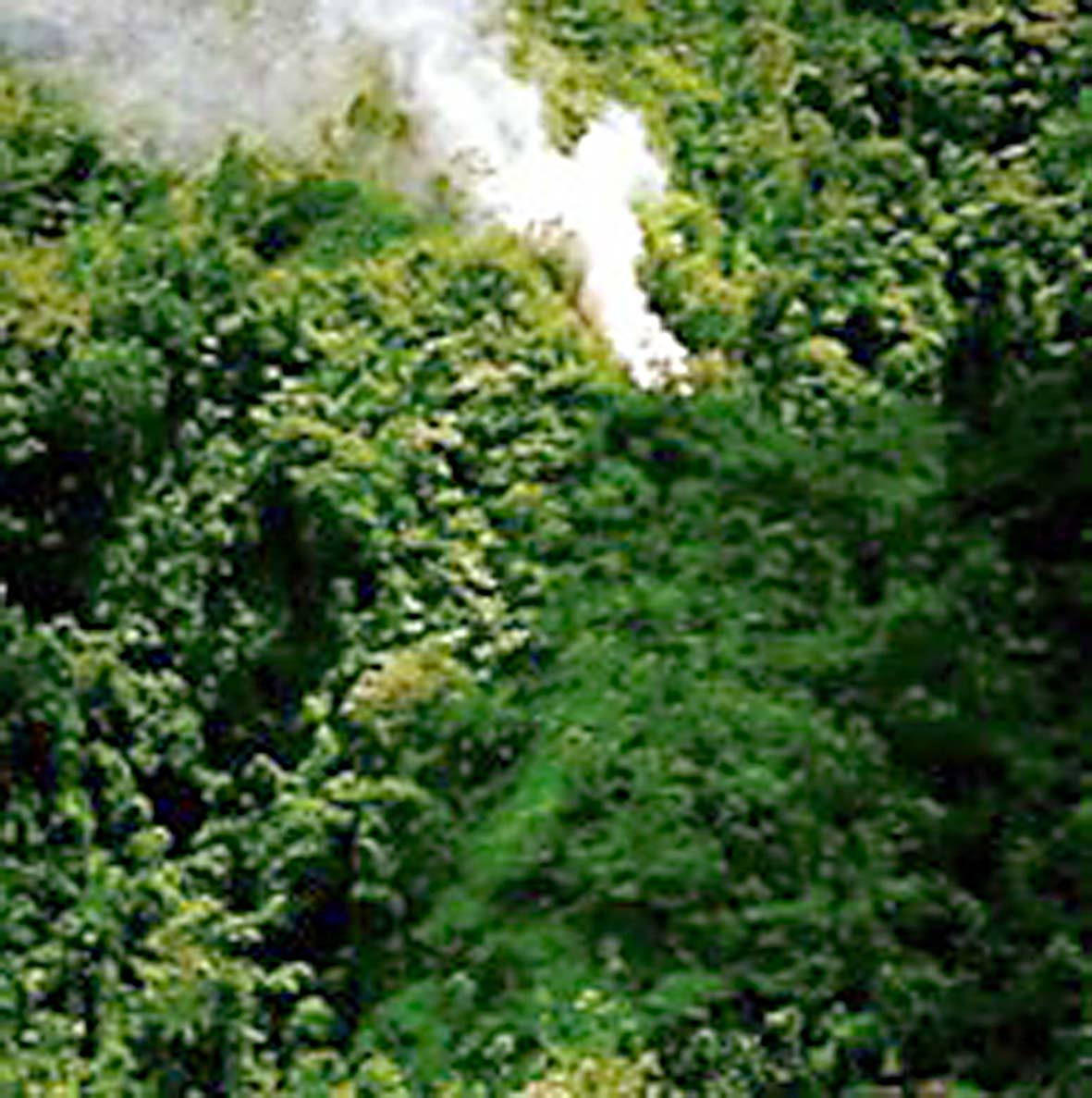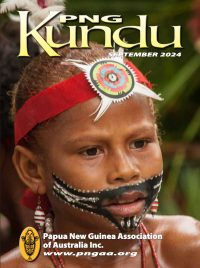Panguna Women After Closure of the Mine
Simon Pentanu
I took this shot from a moving vehicle on a visit to Panguna on 15 January 2016. The photo isn’t great resolution-wise, but please read on.
As our vehicle descended toward the old pump station, my long vision was staring in the direction of the Jaba River imagining its estuarine destination and formation near the delta before it flowed into the sea on the west coast. The milo-coloured flow into the sea was once quite noticeable from the air flying direct from Port Moresby into Kieta (Aropa) airport. But on this day as I also looked up to the hills, something else, much closer than the meandering Jaba flowing down to the west coast, drew my eyes. There was smoke rising above a village, at this altitude it looked starkly white against the green alpine forest. I say at this altitude, as Panguna is smack in the centre of the island, high up in the Crown Prince Range.
Smoke from forest garden plots under slash and burn is a familiar sight growing up in a village anywhere in Bougainville. The smoke from the forest that I was watching had become more and more noticeable as the breeze carried it farther up and away. Where there’s smoke there’s fire, and in this part of the world’s habitat, where there’s fire, there are women toiling and cleaning plots, and making new gardens. After the land is cleared women make gardens pretty much as they have been for yonks, to produce garden food as a staple for family meals.
After the Panguna mine was abruptly closed in late 1989, women could first slowly, but over time, surely go back to work some of their gardens on the land. In Panguna, the women still have arable land on distant peripheries to the open-cut mine as well as further up the slopes.
As I kept watching, I also noticed two other areas in the distance where white smoke rose out of the bush, from the forest floor on the hilly peripheries of one of the largest closed open-cut mines in the world, Panguna, in Bougainville’s Crown Prince Range. Where there is white smoke rising, there is a mother weeding, toiling, and gardening, on the forest floor. Up here it was in the hills that remained unscathed physically from mining but in many ways, not spared from its effects on the human population in the villages and hamlets around here.
Women in Panguna represent what I call a relentless and admirable effort in the face of and against, two devastating experiences. They’ve had to put up with mining and its ruinous effects all around their valley. And if that wasn’t enough, they also bore the brunt of the human suffering dealt to them and their children from causes triggered by the mining on their land. Despite all of this, more women have kept working the land, ploughing, planting and harvesting the fruits of their labour to maintain the family unit in the face of challenges of development.
A mother in the village is at one with Mother Earth, she never ever doubts the motherland will provide all the bare and sumptuous necessities of life. It is her maternal duty, a labour of love, to feed her children. Her spouse also brings game from the forest, and fish and prawns from nearby rivers and creeks.
Development, progress, growth and impact projects have continued to be misnomers for the rural majority that are subsistent, self-sufficient, interdependent and content. Food security also means you cannot eat money, but you should still grow, gather, hunt or catch, for sustenance. This is what the world is coming to, not what Referendum and Independence promise, which is trying to catch up with the rest of the world and be like the Joneses or join the rat race with the Toms, Dicks, Harrys and Muhammads.
On these hills and mountains, in the rift valleys and ravines, along the river banks and meandering creeks, the possibility of a contented self-sustaining existence is no more or no less than living and surviving in the modern, civilised world, with its unique and limitless possibilities to do well.
Mothers though will say this to you: theirs is a symbiotic and mutually belonging relationship together with Mother Earth where they live for each other every day. It is not an existential crisis or struggle for survival. They belong to the land; they aren’t separate from it. They sow and reap with care and respect without ripping into the guts and disembowelling their land.
For the mothers up here in Panguna, peace has come in many respects and means many things, more than merely an end to mining and the end of a brutal and devastating conflict. The most telling thing they are seeing after the mine was forcibly closed is that the land is replenishing and renewing itself albeit it will never ever be the same again.
Their consolation is that without mining, machinery and the constant noise, they get better root crop harvests, many more fingers on banana bunches, healthy sweet potato from the soil mounds, firm and oilier ground nuts, and plentiful fruits and vegetables. There are also more grasshoppers that have come back, often to their annoyance.
Maybe even the copper, gold and silver that attracted a monstrous mine up here are replenishing and growing to replace what was mined and taken out and away.
The other thing that is quite telling and that makes life worth living as they knew it, is this: since mining stopped, women in Panguna have experienced and benefited from the power of quiet in their own environment which was always disturbed by an unrelenting world of the noise of men, and machines digging and ripping out the heart of their land.
Life in the village usually starts earlier for women than men. When he may be still taking time to get up and wipe his eyes awake, she has left for the garden with her metal and wooden implements to continue from where she left her gardening yesterday or the other day. Seeing rising thick and thin white smoke here and there from the gardens on hilly and forested peripheries of the mine means life is slowly returning to normal. But has it really?
With alluvial mining all around Panguna, around the river banks and creek estuaries, even on the hillsides the earth is being dug by hand to the extent of dangerously caving in and collapsing. Mining still goes on by hand, often proving a scavenger’s nightmare that, for all the labour, the returns for today might be next to nil. But over time and with a combination of determination, perseverance and luck there are dividends despite the multitude of risks, including health risks. Reliable estimates from some research put earnings from all alluvial mining around Bougainville, but mostly Panguna, in the vicinity of just over K100m.
Down in the old Karoona market though where some of the old market building still stands, the women are back selling their fruits, vegetables and nuts, as they were during the mining days. I have even bought green coconuts in areas where I have not noticed many coconut trees growing before.
The women, I believe, will always have a lot to say about what happens to the land, including any decision on the future of Panguna. They are more connected to the land physically as they toil and harvest it daily. They are also much more connected spiritually as maternal guardians, as they care for the land, using its resources more responsibly to sustain families in this matrilineal society.
For most villages and the population around here, it is debatable whether the huge mining venture really has made a difference to the quality of their lives, whether they are any happier, better off or worse off since the closure of the mine.
Today, women have gone back to gardening the land in a sustainable way to support families long after the mine closed in late 1989.
Editor’s Note: Simon Pentanu is a Bougainvillean author who regularly writes about his homeland.




